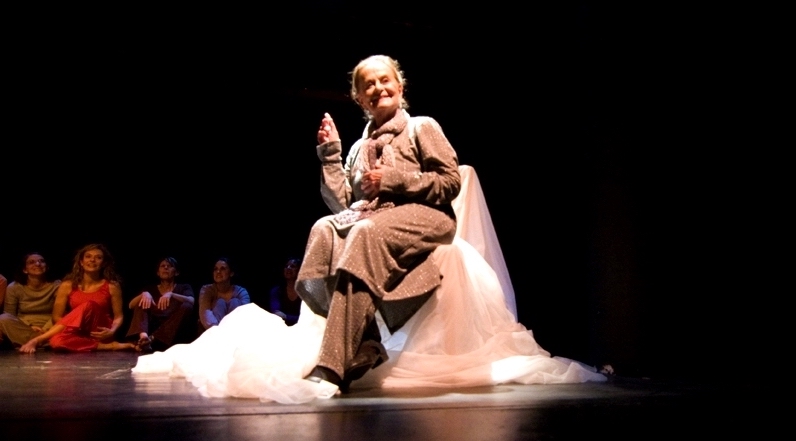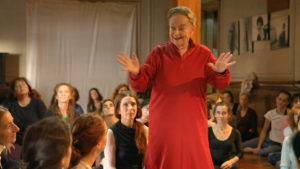María Fux at 100 and counting: The “can-do” attitude - Vancouver Ballet Society
- Home
- Features 2020 - 2023
- María Fux at 100 and counting: The “can-do” attitude

By Anastasia Georgouli
María Fux will celebrate her 101st year on earth on January 2, 2023. Last year, those celebrations took place in her dance school, a neo-classical building in the heart of Buenos Aires. Due to COVID-19, the pioneer in modern dance therapy remained indoors while her students, hundreds of them of all ages, gathered outside on the street. They danced while holding placards emblazoned with “Maria we love you!”
Although the Argentinian dancer, choreographer, and dance therapist stopped teaching a few years ago, movement is still the air she breathes. In a film on YouTube, you can see her, at age 99, sitting in a chair but still dancing, in synch with the environment and the music by Astor Piazolla.

Her movements are known for being harmonized, airy, an experiment in movement, inspired by nature. Her life and work have in turn inspired the Italian film director, Ivan Gergolet, to make the 2014 documentary Dancing with María. In this clip from the film, Fux recalls her first steps finding her inner and outer rhythms while focussing on a leaf as it falls slowly to the earth. She decided to experiment with dancing as that leaf. Nature — life itself — informed her dance and became key to her method.
Fux danced at the Colón Opera House in Buenos Aires in the 1940s and 1950s. From the 1960s, she devoted herself to what she first called creative dance and, later, dance therapy, as suggested by a psychoanalyst friend. “In my classes, I don’t demonstrate what I know or what I don’t know,” she says in a 2010 interview on Argentine television. “I just focus on each student individually and my efforts lie in facilitating them to evolve.” This was the hippy era, when ideas about liberty and freedom were influencing many in Europe and North America.
Fux ran integrated classes, with students varied in age, many with a range of challenges, such as Down syndrome, visual impairment, and anxiety disorders. The unifying characteristic lies in each student using all their available senses and abilities to express themselves in dance. She acts as facilitator rather than teacher, claiming not to actually “teach” anything, trying instead to be a bridge of communication through her lifetime of experience.

Where did she find the “yes, you can do it” attitude she is famous for? It was watching the way her mother coped with moving around doing housework after an infection that had resulted in the removal of her kneecap. Fux tells her students, “Don’t be afraid. If you can’t do this, do something else. If I can’t do one thing, I can do the other. I am the other.”
She developed her dance therapy model in Argentina, but has also worked in Europe, particularly in Italy. Besides professional dancers, she has trained physiotherapists, doctors, and psychologists in using her method in their own work.
A former student of Fux, María José Vexenat, is on the teaching team at the Scuola Risvegli María Fux in Milan. Vexenat was drawn not only by the way Fux taught dance, but also to how her method reinforced her own standpoint about life. The theory and practice of Fux’s method is passed from one generation of students to the next, says Vexenat, and one of her own former students, who has Down syndrome, now teaches dance in a kindergarten in Buenos Aires.
Pietro Farneti, the director of Scuola Risvelgi, told me that when he met Fux, his life totally changed. At that time, he was a struggling actor, searching for new stimuli, a new direction that might prove more successful. He says, “María knows how to draw out the hurt in people and that influenced me a lot.” As Martina Serban, another former student who now teaches dance therapy, puts it: “Her method, simple and profound, goes straight to your heart.”
Mariela Graziano, a physiotherapist specializing in neurological rehabilitation who works in Luxembourg, says that when she took classes with Fux, “She led me to discover the mystery and science of rhythm in people with Parkinson’s, which I now weave into my work. María Fux turned my attention to the right to move, any way one can, without judgement.”
María Fux conceives dance and life as inseparably linked through movement. She champions a space for the creative development of mutual learning, where there is communication between diverse people, and insists that the first step is to respect the diversity within oneself.

